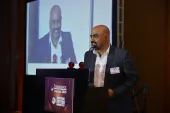
Given the fast-changing market dynamics and regulations, risk chiefs need to step up their game to remain competitive
The need for a risk self-assessment is urgent, says Deloitte’s Wayne Savage.
It’s an insurer's job to assess the risk of their clients to better price premiums and compete in the market for the risk pools they are focused on however, they should in turn take a moment to self-reflect and assess the risks of their own balance sheet to ensure their own financial and capital performance.
This was what Audit & Assurance Partner and FSI Assurance Leader, Wayne Savage of Deloitte Southeast Asia told Insurance Asia in a quick interview as one of the judges of this year’s Insurance Asia Awards, now in its seventh year.
Wayne has 25 years of experience in the financial services sector. He specialises in complex accounting, financial reporting cycles, assurance frameworks, financial risk management, capital and liquidity management, and financial modelling. Wayne plays an active role in engaging with both local and global financial sector regulators in the ongoing development of regulations.
He will bank on his experiences and expertise to pick the next winners of the Insurance Asia Awards.
What are the rising trends you've noticed in the insurance industry in terms of risk assessment?
Insurers need to assess the risk of their clients (underwriting risk) to a better price for risk and compete in the market for the risk pools they are focused on. Having priced the risks for sale, they then need to assess the risks of their own balance sheet to ensure the ongoing appropriate financial and capital performance. The latter is often the domain of the CFO or CRO.
These functions are related, but separate, with the U/W manager/pricing actuary using innovative techniques to better price products, and the CFO/CRO looking at managing the risk of the insurer. On the former, one key trend is to move from point-of-sale underwriting to continuous underwriting, recognising that by monitoring the insured behaviours (using new technology like wearable and IoT devices) the risk over time can be more accurately assessed. Examples here are Discovery Vitality data being used to provide more discrete health and life insurance price point (this can be executed as a reduction in premium through time or accurate rebates). On the GI side, telematics that measure (simply) milage, or (more sophisticated) clients’ driving patterns that correlate to a higher risk of accident provide more accurate motor premiums. These interventions also prompt the client to be more aware of their own risks, and insurers who use these are creating a better risk pool by changing the behaviour of the policyholders through interaction with the insurance product.
It is also interesting to note the establishment of more sophisticated portfolio risk management techniques within larger global insurers (adopting a balance sheet portfolio view of risk). This has seen the emergence of “three manager models”, whereby the first manager focuses on the non-financial/insurance risks, the third manager focuses on the investment-related risks and the second manager focuses on asset-liability management (ALM) risks, adopting more sophisticated hedging techniques.
What continues to challenge insurers despite the rise of the digital age in closing the underinsurance gap in Asia?
My experience is predominantly within the African emerging markets; therefore, I can attempt to answer this question with reference to the underinsurance gap in Africa. Across the African continent, there is a massive trust deficit between insurers and the public. This is further exacerbated by the fact that the sales process (underwriting and fair pricing) is tilted toward more affluent sectors of the economy, (i.e., the price point is tilted toward wealthier customers that are capable of making themselves more insurable). The level of affordability in these markets is reasonably low, given the long-term nature of premiums in several risk classes.
In Asia, we are seeing large scale investments in digital infrastructure at insurers, however, we have noted that this investment predominantly resides within insurance operations. It is more difficult to embed digital automation or intelligent automation into the sales process/cycle of insurers. However, we have seen some introduction of digital in the distribution process to allow for greater access to the products in a COVID world. These initiatives made insurance more accessible to the population, which may help to close the underinsurance gap. However, the rate of adoption of these technologies by the consumers/distributors and the insurance purchasing behaviour of consumers will need to accelerate/change for the underinsurance gap to close further.
Insurers provide risk financing with different sectors and some of these sectors are not inherently green. How do you think insurers should leverage their experience and position as risk financiers to engage relevant stakeholders to transition to a more sustainable business?
Through their underwriting process, insurers have accumulated large amounts of data that reflect the historical relationships between environmental factors and the emergence of risk. Utilising this knowledge to better understand the impact that some of the industry-based climate scenarios will have on their clients’ risk profiles and consequently their underwriting of these risks, insurers are able to proactively engage with their clients to positively influence their clients’ behaviours. In this regard, we have started to see the insurance market in certain geographies, decreasing cover on industrial projects that are not deemed green.
Why is it urgent for insurers to prepare their portfolios for climate risk?
I think that the insurance sector is likely to be the net loser if you understand how the evolution of climate risk will translate into the insurance underwriting process (risk factors). It is therefore imperative for insurers to support their clients reduce their carbon risk. This should hopefully stabilise the equation of premium rates to catastrophe cover.
In your experience, how should regulators and insurers tackle the issue of the increasing cost of climate change?
Regulators need to understand more about the impacts that climate risk stresses have on insurers’ catastrophe models. They should also understand the risk mitigation mechanisms that insurers have with regard to these stresses, including reinsurance. Given the extensive impact that it is envisaged climate risk will have across multiple sectors and geographies, it is important for regulators and insurers, to understand how concentration and correlations of some of these risk factors might emerge. Stress testing as part of an insurer’s strategic planning and risk management processes, (incl. the ORSA process) should become an area of focus. As noted in question 2 above, insurers that adopt a more forward-looking view of these risks might look to remove the cover to risker segments. The latter action could have drastic unintended consequences.



















 Advertise
Advertise










